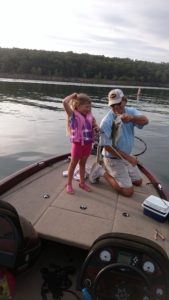Walk through any tackle store and you will see jigs in all sorts of colors, weights and configurations. I could write a book on all the various types of jigs and how they should be used and another volume on all the trailers that are available. In this article I want to break it down with what seems to work best when jig fishing on Table Rock Lake, Lake of the Ozarks and other Midwestern lakes.
Recently we read of the passing of Bassmaster legend Guido Hibdon. Guido managed to be a reckoning force in the tournaments he competed in using small baits like the Guido bug he designed and small jigs fished on spinning gear. The idea was to create a finesse presentation for fish that was often times shying away from bigger baits.
This same thinking comes into play on waters like Table Rock and Bull Shoals where the water clarity can exceed 10 feet at times. A small (1/4 – 5/16 oz) jig rigged with a compact trailer can be the perfect combination when these conditions exist. Natural colors such as PBJ and green pumpkin are great choices with a Bruiser Baits Evil Twin trailer complimenting the jig color. These baits should be pitched to any wood or rock cover as well as brush piles that have been set out.
When in heavier cover or when fishing deeper water, a heavier jig (3/8 oz) should be used to maintain bottom contact. In cold water, a black/blue combination can be good but once the water warms it’s time to go back to the natural colors.
Speaking of colors, consider what you are trying to imitate with your jig. If it’s a crawfish, mimic the colors that are displayed by crawfish (green/orange/black). If fishing around the time of the spawn or pitching around docks you will want to consider jigs that mimic the colors of bluegill (green pumpkin, black, chartreuse and a bit of orange.) This is a great way to load the boat once the sun is high in the sky and the fish have moved to the docks for shade. Pitch your jig to the darkest corners of the dock and between the floats. Then swim it just under the slip walkways. You’ll like the results!
Finally, keep in mind the fact that shad spawn several times each year and when they do the bass feed on them heavily. A white, white with chartreuse, or white with silver strand jig can be deadly when fished in front of bass chasing shad. For this technique, you will want a swim jig which is one with a head configuration designed to glide through the water.
I could go on and explain how sometimes the fish will want the front of the trailer dyed orange and sometimes they want the back of the trailer dyed chartreuse but that will be saved for another day. In the meantime, I encourage you to dig those jigs out of the bottom of your box and start using them. You just might wind up with the fish of a lifetime!

